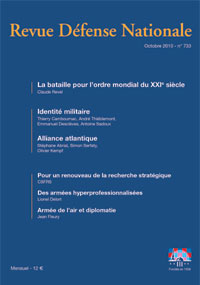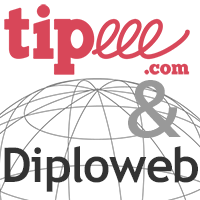In this personal view, the first French supreme allied commander (Supreme Allied Commander Transformation—SACT) sets the evolution of NATO in perspective, reminds us of how the Alliance’s strategy is developed and evokes the new synergies, internal and external, of his organisation.
As part of its strategy of geopolitical synergy, Diploweb.com is pleased to present this article, which first appeared in the French edition of Revue Défense Nationale, October 2010, pp. 47-52.
Cet article sera disponible en anglais dans la livraison de la Revue Défense Nationale de décembre 2010, post sommet de Lisbonne.
61 YEARS after it was founded, the Atlantic Alliance is more than ever one of the main pillars of its members’ security, and more widely one of the leading actors in the global strategic landscape. This long-term success is due primarily to its ability, demonstrated over decades and particularly since the end of the Cold War, to adapt deeply.
Today, NATO is once again called upon to review its objectives and its way of doing things in relation to a changing global environment. And adopting a new Strategic Concept, [...] at the Lisbon summit, will mark a crucial step in this review.
The impact of a new Strategic Concept
The drafting of a new Concept is in itself an event, primarily because it is so uncommon : the previous one dating back to April 1999, this is more than a mere update, given how much the international context has changed. NATO itself doesn’t look quite the same : a few weeks before the 1999 Concept was adopted, it had 12 fewer members than today.
This document will also be unique in its impact : it will embody the consensus of 28 nations, who collectively carry considerable weight—for example, they represent the world’s greatest force projection capability. It explicitly finds inspiration in national ‘white papers’, including the French document of 2008 which was quoted several times during the preparatory work, but its normative value is probably even greater, because the States that approve it will be morally committed to one another. A striking example of this impact is how fast the Nations, represented at the North Atlantic Council, agreed to invoke Article 5 of the Washington Treaty on 12 September 2001, in response to the previous day’s attacks—a responsiveness that owes much to the fact that the terrorist threat had been mentioned as a concern of the Alliance in the Concept adopted two years earlier.
The context in which the new text is prepared is not trivial either. It is worth noting that nothing compelled NATO and its member States to embark upon this exercise—no rule imposes a new Concept at a fixed date. But Secretary General Anders Fogh Rasmussen, like his predecessor, perceived the need to renovate the Alliance’s mandate and inform its priorities, and, as soon as he took office last summer, he launched the process to give NATO a renewed common point of reference.
This hasn’t been only about putting together a document, but also about initiating a series of debates that had been deferred for too long, on topics such as NATO’s role in light of the new threats arising from conventional, ballistic and nuclear proliferation ; the central place taken by cyberspace ; the relationship with a European Union that the Treaty of Lisbon endows with new responsibilities in security and defence ; or the evolution of relationships with strategic partners such as Russia.
Already, these debates have kept their promises. Over the past year, a series of conferences has enabled a wide variety of perspectives to be expressed on a broad range of topics : for example, the last of the four official NATO seminars, co-hosted in Washington by Allied Command Transformation, focused on the military capabilities needed in the future. This cycle has been enriched by a plethora of publications and forums at the initiative of governments—including non-NATO ones—as well as universities and think tanks.
The debate has been of remarkable interest. Experts representing a great diversity of views shared the stage with civilian and military leaders from the Alliance and its member States. Representatives and citizens from nations that were not yet in NATO when the previous Strategic Concept came out were able to contribute on par with those of older member Nations. A significant effort was also made to invite the public into the conversation, including through a dynamic use of new media.
This transparency was best displayed last May when a report was released, commissioned by the Secretary General and drafted by a Group of Experts. Chaired by Madeleine Albright and made up of twelve independent experts, including, from France, Bruno Racine, the committee represented the variety of geopolitical approaches in the Alliance. The result of its work, published six months before the adoption of the Strategic Concept, is accessible to all [1] , and has already helped further widen the circle of debate—especially with the NATO partner nations, who are following our process with the greatest interest.
Never in the history of NATO has the development of such a document been so open and inclusive. I believe that this approach will be reflected in the substance of the coming Concept : this openness should be one of its salient features, as it is a profound and necessary trend in the evolution of Alliance.
A NATO more open internally
Recent years were indeed marked by discernable changes in NATO, resulting in a rebalancing between its members’ viewpoints. The debates around the Strategic Concept confirmed this trend, reaffirming the importance of principles such as the consensus rule for North Atlantic Council decisions, and the revitalization of the Washington Treaty’s Article 4, which provides for systematic consultation between the Allies about their security concerns.
France’s full return and the gesture of our allies to appoint a European to the post of Strategic Commander for the very first time were also significant signs of this evolution towards more internal dialogue. Every day, I see this rebalancing gain strength—and I take an active part in it, notably by ensuring that defence contractors from both sides of the Atlantic enjoy equal visibility on the direction my command is taking on future capability issues, or making sure that ACT, in his role as a NATO military ‘think tank’ for example, entertains links with European as well as North American governmental and non-governmental counterparts.
A critical aspect of this development is how the Alliance recognizes the unique place occupied by the European Union, to which 21 of its members also belong, particularly since the adoption of the Lisbon Treaty and the development of a Common Security and Defence Policy. That fact that the NATO and US-EU summits will follow each other back-to-back, both in the presence of the US President, in Lisbon on the coming 19 and 20 November, is a powerful symbol of this.
The report submitted by the Group of Experts additionally insisted on this relationship by describing the EU as a ‘unique and essential partner.’ No doubt the Concept itself will confirm this recognition, and open the door to finding growing synergies, like those that I am already pursuing, in compliance with the agreed framework and procedures, with partners such as the European Defence Agency. We are working with them to ensure that our thinking on future capabilities is more harmonious and to reach concrete and practical cooperation on often hot topics such as medical support in operations or the fight against IEDs.
This idea of a more open NATO also translates in the way we conduct transformation within the Alliance itself. Indeed, my vision is characterized by a desire to better highlight the diversity of current and potential capabilities in the 28 member countries. One promising example is helping nations make better use of their training capabilities by opening them up more widely to Allied and partner trainees, thus avoiding unintentional duplication and guaranteeing our citizens a better return for every euro or dollar invested. Emblematic of this mindset is the development of our network of over a dozen Centres of Excellence, each of which maintains an expertise in a specific area that fills a gap for the benefit of all members of the Alliance : civil-military matters in the Netherlands ; cyber-defence in Estonia ; medical support to operations in Hungary ; or air command and control issues at the Centre for Analysis & Simulation for the Preparation of Air Operations [2] in Taverny, France.
Outreach to partners
More openness inside naturally goes hand in hand with greater openness with our partners, who have taken part to an unprecedented degree in the debates around the new Strategic Concept. Tomorrow’s NATO will clearly seek an even better collaboration with members of the Partnership for Peace, the Istanbul Cooperation Initiative, or the Mediterranean Dialogue, as well as with other countries that regularly contribute to the Alliance efforts—Australia, New Zealand or Japan, for example, and perhaps others tomorrow.
These countries are truly part of the ‘extended family’ of NATO : many are at our side in operations in both Afghanistan and Kosovo, off the coast of Somalia or in our anti-terrorist surveillance operation in the Mediterranean. In a common operation, we cannot be satisfied to have NATO on one side and our partners on the other, particularly in terms of interoperability. We owe it to our brothers in arms to help them access all of our training resources, well in advance of the operations themselves.
Russia, itself a member of the Partnership for Peace, deserves special treatment, of course. The attention it received in the Albright report, as well as repeated statements by Secretary General Rasmussen and recent initiatives promoted by President Sarkozy, ensure that the new Strategic Concept will reflect this importance. Nourishing a genuine strategic partnership with Russia is undoubtedly a major stake for NATO and the entire Euro-Atlantic region in the years to come. Military cooperation, admittedly contingent on political relations, is in this perspective a promising way to develop trust and, perhaps, make the possible common strategic concerns more apparent—as was shown in a recent visit in Moscow by the Chairman of the NATO Military Committee, Admiral Giampaolo Di Paola, during which the fight against terrorism and the protection of freedom of movement in the maritime commons were high on the agenda.
Openness to a wider range of actors
In addition, tomorrow’s NATO must develop a sustained cooperation with a wider range of players—from the various government agencies to other international organizations or NGOs. The experience from recent commitments shows that the military cannot solve a crisis on its own, but also that solving any major crisis requires a military contribution. A comprehensive effort, involving many actors, has proven essential in all recent or ongoing operations : in Afghanistan, in a counter-insurgency context ; in the Mediterranean, where our operation against the trafficking of illicit material, Operation Active Endeavour, requires a thorough coordination with port authorities from the neighbouring countries, whether or not they are part of NATO ; and even in crises such as the response to the earthquake in Haiti last winter.
We, in NATO, and we, the military, have a role to play in facilitating greater synergy between the often considerable means deployed during a crisis by these diverse stakeholders, military as well as civilian. We have a responsibility to reach out to others and discuss with them a framework that enables better cooperation, with a focus on realism : we must not seek unity of command, but a synergy of effects. This is not a question of integrating our partners to our organization chart, but of determining on a case-by-case basis how, and how much, to coordinate our actions. It is therefore important for NATO to develop qualities of openness and adaptability that may not have characterized the organization under the pressure of the Cold War, but increasingly need to be part of the DNA of a renewed Alliance.
Ideally, we need to work better with some major players, such as international organizations, on a day to day basis, without putting it off to when we are deployed alongside each other in a same crisis area : it has to take place in exercises, which have a critical role in shaping our operational culture and improving mutual understanding, and in the planning before deployment. I am intent on developing contacts in the United Nations—a concern shared by the Experts’ report, which suggests creating a permanent NATO liaison office at the UN. In every theatre, the UN and its civilian agencies are indeed among our most important partners. They are an essential player in any comprehensive approach, and are often best placed to ensure its coordination.
The Strategic Concept and NATO reform
Finally, the Strategic Concept is difficult to dissociate from the ambitious reform in which the Secretary General has engaged NATO, and which concerns its military and civilian structures, including its many committees and agencies, as well as its financial practices.
In the words of the French President, the Alliance is determined to "reform, put its structure on a diet, and adapt to the changing international situation." [3] In my current role, I can attest to the extra boost the full reintegration of our country into the NATO structures has given this reform. The Alliance may still reflect decisions made when our nation did not have a full voice in it, but that time is over, and the NATO of the twenty-first century will be what we—including we, the French—make of it.
As for me, at Allied Command Transformation, I stand ready to actively implement all the decisions that will come out of this dual exercise, the Concept and the reform, especially in their military implications. The Experts’ report advocated that ACT be given a ‘bolder mandate’—which my command is ready to assume if that is what the Nations want. Despite the difficulties of the current budgetary context, ACT is particularly committed to supporting NATO and its members better spend their resources, and successfully face the challenges of the decades to come.
There will be more than a few of these. The numerous dramatic changes of recent years, such as the emergence of new economic giants or the increased availability of high-end technology, are the sources of new risks that no one nation can meet alone. In such a context, NATO still has much to contribute to the security of our country. Our task now is to take our full part in the reform and transformation of a unique political and military tool and the construction of the Alliance our nations will need tomorrow.
Copyright Octobre 2010-Abrial/Revue Défense Nationale

Published since 1939 by the Committee for National Defence Studies, Revue Défense Nationale has since then concerned itself with looking at new ideas on the big national and international issues from the viewpoint of security and defence. Its editorial independence allows it to participate actively in revival of the strategic debate in France and in promoting it in Europe and the rest of the world. See
Pour ne rien rater de nos nouvelles publications, abonnez-vous à la Lettre du Diploweb !
[1] "Otan 2020 : une sécurité assurée, un engagement dynamique" (www.nato.int).
[2] Centre d’analyse et de simulation pour la préparation des opérations aériennes
[3] Allocution devant la XVIIIe conférence des ambassadeurs, 25 août 2010
Direction

Directeur, P. Verluise
Conseil scientifique
Mentoring et coaching géopolitique
Présenter le Diploweb.com
Charte du site
Auteurs
Proposer un article
Retrouvez la chaîne Diploweb sur :











